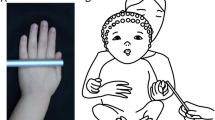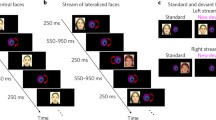Abstract
Topographically organised responses to visual and tactile stimulation are aligned in the ventral intraparietal cortex. The critical biological importance of this region, which is thought to mediate visually guided defensive movements of the head and upper body, suggests that these maps might be hardwired from birth. Here, we investigated whether visual experience is necessary for the creation and positioning of these maps by assessing the representation of tactile stimulation in congenitally and totally blind participants, who had no visual experience, and late and totally blind participants. We used a single-subject approach to the analysis to focus on the potential individual differences in the functional neuroanatomy that might arise from different causes, durations and sensory experiences of visual impairment among participants. The overall results did not show any significant difference between congenitally and late blind participants; however, single-subject trends suggested that visual experience is not necessary to develop topographically organised maps in the intraparietal cortex, whilst losing vision disrupted topographic maps’ integrity and organisation. These results discussed in terms of brain plasticity and sensitive periods.



Similar content being viewed by others
References
Ackroyd C, Humphrey NK, Warrington EK (1974) Lasting effects of early blindness: a case study. Q J Exp Psychol 26:114–124
Araneda R, Renier LA, Rombaux P, Cuevas I, De Volder AG (2016) Cortical plasticity and olfactory function in early blindness. Front Sys Neurosci 10:75
Astafiev SV, Shulman GL, Stanley CM, Snyder AZ, Van Essen DC, Corbetta M (2003) Functional organization of human intraparietal and frontal cortex for attending, looking, and pointing. J Neurosci 23:4689–4699
Bedny M, Pascual-Leone A, Dodell-Feder D, Fedorenko E, Saxe R (2011) Language processing in the occipital cortex of congenitally blind adults. Proc Nat Acad Sci USA 108:4429–4434
Beer AL, Plank T, Greenlee MW (2011) Diffusion tensor imaging shows white matter tracts between human auditory and visual cortex. Exp Brain Res 213:200–308
Bremmer F, Schlack A, Jon Shah N, Zafiris O, Kubischik M, Hoffmann K-P et al (2001) Polymodal motion processing in posterior parietal and premotor cortex: a human fMRI study strongly implies equivalencies between humans and monkeys. Neuron 29:287–296
Burkhalter A, Bernardo KL (1989) Organization of corticocortical connections in human visual cortex. Proc Natl Acad Sci USA 86:1071–1075
Carlson S, Hyvärinen L, Raninen A (1986) Persistent behavioural blindness after early visual deprivation and active visual rehabilitation: a case report. Brit J Ophthal 70:607–611
Castronovo J, Seron X (2007) Semantic numerical representation in blind subjects: the role of vision in the spatial format of the mental number line. Q J Exp Psychol 60:101–119
Cecchetti L, Ricciardi E, Handjaras G, Kupers R, Ptito M, Pietrini P (2015) Congenital blindness affects diencephalic but not mesencephalic structures in the human brain. Brain Struc Funct 221:1–16
Colby CL, Duhamel JR, Goldberg ME (1993) Ventral intraparietal area of the macaque: anatomic location and visual response properties. J Neurophysiol 69:902–902
Coluccia E, Mammarella I, Cornoldi C (2009) Centred egocentric, decentred egocentric, and allocentric spatial representations in the peripersonal space of congenital total blindness. Perception 38:679–693
Cooke DF, Graziano MS (2003) Defensive movements evoked by air puff in monkeys. J Neurophysiol 90:3317–3329
Culham JC, Kanwisher NG (2001) Neuroimaging of cognitive functions in human parietal cortex. Curr Opin Neurobiol 11:157–163
Culham JC, Brandt SA, Cavanagh P, Kanwisher NG, Dale AM, Tootell RB (1998) Cortical fMRI activation produced by attentive tracking of moving targets. J Neurophysiol 80:2657–2670
Fadiga L (2007) Functional magnetic resonance imaging: measuring versus estimating. Neuroimage 37:1042–1044
Felleman DJ, Van Essen DC (1991) Distributed hierarchical processing in the primate cerebral cortex. Cereb Cortex 1:1–47
Fine I, Wade AR, Brewer AA, May MG, Goodman DF, Boynton GM et al (2003) Long-term deprivation affects visual perception and cortex. Nat Neurosci 6:915–916
Finocchietti S, Cappagli G, Gori M (2017) Auditory spatial recalibration in congenital blind individuals. Front Neurosci 11:76
Gori M, Sandini G, Martinoli C, Burr DC (2010) Poor haptic orientation discrimination in nonsighted children may reflect disruption of cross-sensory calibration. Curr Biol 20:223–225
Gori M, Sandini G, Martinoli C, Burr DC (2014) Impairment of auditory spatial localization in congenitally blind human subjects. Brain 137:288–293
Graziano MS, Gandhi S (2000) Location of the polysensory zone in the precentral gyrus of anesthetized monkeys. Exp Brain Res 135:259–266
Greenlee MW, Frank SM, Kaliuzhna M, Blanke O, Bremmer F, Churan J et al (2016) Multisensory integration in self motion perception. Multisens Res 29:525–556
Guerreiro MJ, Putzar L, Röder B (2015) The effect of early visual deprivation on the neural bases of multisensory processing. Brain 138:1499–1504
Hensch TK (2005) Critical period plasticity in local cortical circuits. Nat Rev Neurosci 6:877–888
Hötting K, Röder B (2004) Hearing cheats touch, but less in congenitally blind than in sighted individuals. Psychol Sci 15:60–64
Huang RS, Sereno MI (2007) Dodecapus: an MR-compatible system for somatosensory stimulation. Neuroimage 34:1060–1073
Huang RS, Sereno MI (2018) Multisensory and sensorimotor maps. Handb Clin Neurol 151:141–161
Huang RS, Chen CF, Tran AT, Holstein KL, Sereno MI (2012) Mapping multisensory parietal face and body areas in humans. Proc Nat Acad Sci USA 109:18114–18119
Huang RS, Chen CF, Sereno MI (2017) Mapping the complex topological organization of the human parietal face area. Neuroimage 163:459–470
Huang RS, Chen CF, Sereno MI (2018) Spatiotemporal integration of looming visual and tactile stimuli near the face. Hum Brain Mapp 39:2156–2176
Iachini T, Ruggiero G, Ruotolo F (2014) Does blindness affect egocentric and allocentric frames of reference in small and large scale spaces? Behav Brain Res 273:73–81
Jiang J, Zhu W, Shi F, Liu Y, Li J, Qin W et al (2009) Thick visual cortex in the early blind. J Neurosci 29:2205–2211
Kakei S, Hoffman DS, Strick PL (1999) Muscle and movement representations in the primary motor cortex. Science 285:2136–2139
Kosslyn SM, Pascual-Leone A, Felician O, Camposano S, Keenan JP, Ganis G et al (1999) The role of area 17 in visual imagery: convergent evidence from PET and rTMS. Science 284:167–170
Kourtzi Z, Kanwisher N (2000) Activation in human MT/MST by static images with implied motion. J Cogn Neurosci 12:48–55
Loomis JM, Klatzky RL, Golledge RG, Cicinelli JG, Pellegrino JW, Fry PA (1993) Nonvisual navigation by blind and sighted: assessment of path integration ability. J Exp Psychol Gen 122:73–91
McCarthy G, Allison T, Spencer DD (1993) Localization of the face area of human sensorimotor cortex by intracranial recording of somatosensory evoked potentials. J Neurosurg 79:874–884
Noppeney U, Friston KJ, Ashburner J, Frackowiak R, Price CJ (2005) Early visual deprivation induces structural plasticity in gray and white matter. Curr Biol 15:488–490
Orban GA, Fize D, Peuskens H, Denys K, Nelissen K, Sunaert S et al (2003) Similarities and differences in motion processing between the human and macaque brain: evidence from fMRI. Neuropsychologia 41:1757–1768
Pan WJ, Wu G, Li CX, Lin F, Sun J, Lei H (2007) Progressive atrophy in the optic pathway and visual cortex of early blind Chinese adults: a voxel-based morphometry magnetic resonance imaging study. Neuroimage 37:212–220
Papadopoulos K, Koustriava E, Kartasidou L (2011) The impact of residual vision in spatial skills of individuals with visual impairments. J Spec Educ 45:118–127
Pasqualotto A, Newell FN (2007) The role of visual experience on the representation and updating of novel haptic scenes. Brain Cogn 65:184–194
Pasqualotto A, Proulx MJ (2012) The role of visual experience for the neural basis of spatial cognition. Neurosci Biobehav Rev 36:1179–1187
Pasqualotto A, Lam JSY, Proulx MJ (2013a) Congenital blindness improves semantic and episodic memory. Behav Brain Res 244:162–165
Pasqualotto A, Spiller MJ, Jansari AS, Proulx MJ (2013b) Visual experience facilitates allocentric spatial representation. Behav Brain Res 236:175–179
Pasqualotto A, Taya S, Proulx MJ (2014) Sensory deprivation: visual experience alters the mental number line. Behav Brain Res 261:110–113
Penfield W, Boldrey E (1937) Somatic motor and sensory representation in the cerebral cortex of man as studied by electrical stimulation. Brain 60:389–443
Postma A, Zuidhoek S, Noordzij ML, Kappers AML (2008) Keep an eye on your hands: on the role of visual mechanisms in processing of haptic space. Cogn Proc 9:63–68
Qin W, Liu Y, Jiang T, Yu C (2013) The development of visual areas depends differently on visual experience. PLoS One 8:e53784
Rizzolatti G, Fogassi L, Gallese V (2002) Motor and cognitive functions of the ventral premotor cortex. Curr Opin Neurobiol 12:149–154
Röder B, Rösler F, Spence C (2004) Early vision impairs tactile perception in the blind. Curr Biol 14:121–124
Sadato N, Okada T, Honda M, Yonekura Y (2002) Critical period for cross-modal plasticity in blind humans: a functional MRI study. Neuroimage 16:389–400
Sereno MI, Allman JM (1991) Cortical visual areas in mammals. In: Leventhal AG (ed) The neural basis of visual function. Macmillan, London, pp 160–172
Sereno MI, Huang RS (2006) A human parietal face area contains aligned head-centered visual and tactile maps. Nat Neurosci 9:1337–1343
Sereno MI, Tootell RB (2005) From monkeys to humans: what do we now know about brain homologies? Curr Opin Neurobiol 15:135–144
Sereno MI, Pitzalis S, Martinez AM (2001) Mapping of contralateral space in retinotopic coordinates by a parietal cortical area in humans. Science 294:1350–1354
Sherrick CE, Rogers R (1966) Apparent haptic movement. Perc Psychophys 1:75–180
Smith PL, Little D (2018) Small is beautiful: in defense of the small-N design. Psychon Bull Rev. https://doi.org/10.3758/s13423-018-1451-8
Takemura A, Kawano K, Quaia C, Miles FA (2002) Population coding in cortical area MST. Ann NY Acad Sci 956:284–296
Talairach J, Tournoux P (1988) Co-planar stereotaxic atlas of the human brain. Thieme, Stuttgart
Uesaki M, Ashida H (2015) Optic-flow selective cortical sensory regions associated with self-reported states of vection. Front Psychol 6:775
Uesaki M, Takemura H, Ashida H (2018) Computational neuroanatomy of human stratum proprium of interparietal sulcus. Brain Struc Funct 223:489–507
Vercillo T, Burr D, Gori M (2016) Early visual deprivation severely compromises the auditory sense of space in congenitally blind children. Dev Psychol 52:847–853
Wang D, Qin W, Liu Y, Zhang Y, Jiang T, Yu C (2013) Altered white matter integrity in the congenital and late blind people. Neural Plast 2013:128236
Acknowledgements
This work was supported by a Marie Curie IEF (Grant number: PIEF-GA-2010-274163) and a Grant from the EPSRC (EP/J017205/1).
Author information
Authors and Affiliations
Corresponding author
Rights and permissions
About this article
Cite this article
Pasqualotto, A., Furlan, M., Proulx, M.J. et al. Visual loss alters multisensory face maps in humans. Brain Struct Funct 223, 3731–3738 (2018). https://doi.org/10.1007/s00429-018-1713-2
Received:
Accepted:
Published:
Issue Date:
DOI: https://doi.org/10.1007/s00429-018-1713-2




